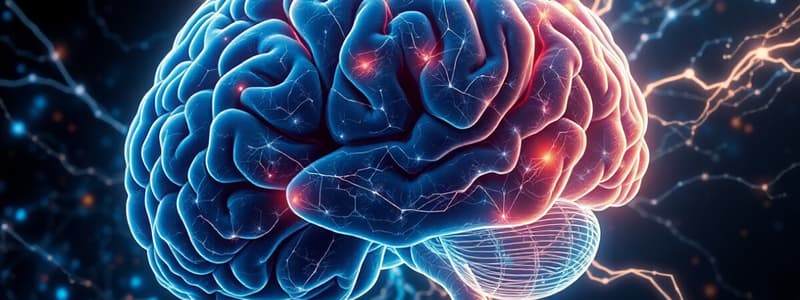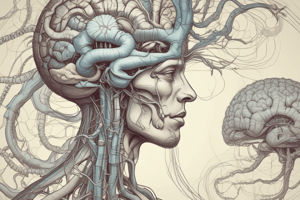Podcast
Questions and Answers
Which hemisphere is typically dominant for language functions?
Which hemisphere is typically dominant for language functions?
- Both hemispheres equally
- Neither hemisphere
- Left hemisphere (correct)
- Right hemisphere
What condition may arise from damage to the posterior association area?
What condition may arise from damage to the posterior association area?
- Memory loss for recent events
- Contralateral neglect (correct)
- Impaired language comprehension
- Difficulty in emotional regulation
Wernicke's area is primarily involved in which of the following?
Wernicke's area is primarily involved in which of the following?
- Emotional responses
- Motor control
- Understanding written and spoken language (correct)
- Visual-spatial skills
How does the anterior association area contribute to personality?
How does the anterior association area contribute to personality?
What is cerebral dominance typically associated with in terms of handedness?
What is cerebral dominance typically associated with in terms of handedness?
Phineas Gage is a historically significant case because it showed a link between brain injury and which of the following?
Phineas Gage is a historically significant case because it showed a link between brain injury and which of the following?
What role does the limbic association area play in emotional responses?
What role does the limbic association area play in emotional responses?
In terms of neural communication, how do the two hemispheres of the brain interact?
In terms of neural communication, how do the two hemispheres of the brain interact?
What is the primary function of the premotor cortex?
What is the primary function of the premotor cortex?
What characteristic is unique to Broca's area?
What characteristic is unique to Broca's area?
What does the primary somatosensory cortex (PSC) primarily process?
What does the primary somatosensory cortex (PSC) primarily process?
What happens when there is damage to the area of the premotor cortex responsible for keyboarding?
What happens when there is damage to the area of the premotor cortex responsible for keyboarding?
In which hemisphere of the brain is Broca's area typically located?
In which hemisphere of the brain is Broca's area typically located?
Which area of the brain integrates and analyzes somatic sensory inputs?
Which area of the brain integrates and analyzes somatic sensory inputs?
What does the frontal eye field control?
What does the frontal eye field control?
Why is the term 'muscle memory' considered misleading?
Why is the term 'muscle memory' considered misleading?
What primarily distinguishes gray matter from white matter in the nervous system?
What primarily distinguishes gray matter from white matter in the nervous system?
Which of the following correctly describes the function of the sympathetic division of the autonomic nervous system?
Which of the following correctly describes the function of the sympathetic division of the autonomic nervous system?
Which structures are part of the diencephalon?
Which structures are part of the diencephalon?
What is the primary function of the cerebral ventricles?
What is the primary function of the cerebral ventricles?
What is the role of ependymal cells in relation to the brain's ventricles?
What is the role of ependymal cells in relation to the brain's ventricles?
Which division of the peripheral nervous system is responsible for carrying motor signals from the CNS to skeletal muscles?
Which division of the peripheral nervous system is responsible for carrying motor signals from the CNS to skeletal muscles?
Which structure in the brain plays a key role in language processing?
Which structure in the brain plays a key role in language processing?
The basal nuclei are associated with which of the following functions?
The basal nuclei are associated with which of the following functions?
Flashcards
Premotor Cortex Function
Premotor Cortex Function
Plans and sequences complex movements, coordinating multiple muscle groups.
Central Nervous System (CNS)
Central Nervous System (CNS)
The part of the nervous system that includes the brain and spinal cord; it integrates information and sends commands.
Broca's Area Function
Broca's Area Function
Active in speech preparation and organization; not just motor speech.
Peripheral Nervous System (PNS)
Peripheral Nervous System (PNS)
Signup and view all the flashcards
Sensory Division (PNS)
Sensory Division (PNS)
Signup and view all the flashcards
Frontal Eye Field Function
Frontal Eye Field Function
Signup and view all the flashcards
Primary Somatosensory Cortex (PSC) Location
Primary Somatosensory Cortex (PSC) Location
Signup and view all the flashcards
Motor Division (PNS)
Motor Division (PNS)
Signup and view all the flashcards
Gray Matter
Gray Matter
Signup and view all the flashcards
Primary Somatosensory Cortex (PSC) Function
Primary Somatosensory Cortex (PSC) Function
Signup and view all the flashcards
White Matter
White Matter
Signup and view all the flashcards
Somatosensory Association Cortex Location
Somatosensory Association Cortex Location
Signup and view all the flashcards
Somatosensory Association Cortex Function
Somatosensory Association Cortex Function
Signup and view all the flashcards
Ventricles of the Brain
Ventricles of the Brain
Signup and view all the flashcards
Cerebrospinal Fluid (CSF)
Cerebrospinal Fluid (CSF)
Signup and view all the flashcards
Damage to premotor keyboard area
Damage to premotor keyboard area
Signup and view all the flashcards
Anterior Association Area
Anterior Association Area
Signup and view all the flashcards
Phineas Gage Case
Phineas Gage Case
Signup and view all the flashcards
Posterior Association Area
Posterior Association Area
Signup and view all the flashcards
Contralateral Neglect
Contralateral Neglect
Signup and view all the flashcards
Limbic Association Area
Limbic Association Area
Signup and view all the flashcards
Lateralization of Cortical Functioning
Lateralization of Cortical Functioning
Signup and view all the flashcards
Cerebral Dominance
Cerebral Dominance
Signup and view all the flashcards
Wernicke's area
Wernicke's area
Signup and view all the flashcards
Study Notes
Central Nervous System (CNS)
- The nervous system is a single unit, anatomically divided into two parts:
- Central Nervous System (CNS):
- Consists of the brain and spinal cord
- Acts as the integrating and command center
- Peripheral Nervous System (PNS):
- Includes cranial and spinal nerves
- Facilitates communication between the CNS and the body
- Central Nervous System (CNS):
Sensory and Motor Divisions
- Sensory division:
- Somatic and visceral fibers carry signals from receptors to the CNS.
- Motor division:
- Motor nerve fibers carry signals from the CNS to effectors.
- Somatic nervous system: controls voluntary movements, targeting skeletal muscles.
- Autonomic nervous system: regulates involuntary functions, affecting cardiac muscle, smooth muscle, and glands.
- Sympathetic division: "fight or flight" response
- Parasympathetic division: conserves energy during rest
Brain Structure
- Complexity of wiring is more important than size
- Subdivisions:
- Cerebral hemispheres
- Diencephalon (thalamus, hypothalamus, epithalamus)
- Brain stem (midbrain, pons, medulla)
- Cerebellum
Gray and White Matter
- Gray matter:
- Consists of short, nonmyelinated neurons and neuron cell bodies
- Some gray matter is organized into nuclei
- Some is distributed as cortical areas
- White matter:
- Primarily myelinated axons
- Some nonmyelinated axons may also be present
Spinal Cord Structure
- Central cavity surrounded by gray matter (butterfly shape).
- White matter surrounds the gray matter.
- Brain displays similar design, but with additional gray matter regions, particularly in the cerebral hemispheres and cerebellum.
Ventricles of the Brain
- Continuous with each other and the central cavity of the spinal cord.
- Filled with cerebrospinal fluid (CSF).
- Lined with ependymal cells.
- Paired lateral ventricles are separated by the septum pellucidum.
- Each communicates with a narrow third ventricle.
- The third ventricle connects to the fourth ventricle via the cerebral aqueduct.
- The fourth ventricle continues with the central canal.
- Three apertures connect the ventricles to the subarachnoid space, which surrounds the brain.
Cerebral Hemispheres
- Superior part (~83% of brain mass)
- Gyri are separated by sulci.
- Anatomical landmarks include the longitudinal fissure and a transverse fissure
- Lobes (frontal, parietal, occipital, temporal, insular)
- Central sulcus separates precentral/postcentral gyrus.
- Other important sulci include the parieto-occipital and lateral sulci.
Cerebral Cortex (Gray Matter)
- Enables perception, communication, memory, understanding, appreciation, and voluntary movements (conscious behavior)
- Cell bodies, dendrites, and unmyelinated axons comprise a thin layer (2-4 mm), although convolutions increase the surface area.
- Brodmann areas (BA) are numbered based on thickness and histology.
- Functional areas include motor, sensory, and association areas.
- Each hemisphere handles sensory and motor functions of the opposite (contralateral) side of the body.
Functional Areas
- Motor areas:
- Primary motor cortex (BA4): precentral gyrus: controls skeletal muscles (axons project to spinal cord)
- Premotor cortex (BA6): plans and sequences motor movements, sometimes referred to as muscle memory.
- Broca's area (BA44): organizes the sounds that become words.
- Frontal eye field (close to BA 8): controls voluntary eye movements.
- Sensory areas:
- Primary somatosensory cortex (PSC) (BA1-3) in the postcentral gyrus: receives info from somatic sensory receptors (skin and proprioceptors).
- Includes spatial discrimination.
- Somatosensory association cortex (BA 5-7): integrates sensory input.
- Visual areas:
- Primary visual cortex (PVC) in the posterior tip of the occipital lobe.
- Contains map of visual space on retina (contralateral)
- Visual association: surrounds PVC, interprets visual images, recognizes faces, letters.
Auditory areas
- Primary auditory cortex processes sound based on pitch, rhythm, and loudness
- Auditory association area interprets sound in relation to memory (speech, words, music.
Vestibular cortex
- Awareness of balance - posterior part of insula and adjacent parietal cortex (in the lateral sulcus).
Olfactory cortex
- Medial aspects of temporal lobes (the uncus)
- Important part of the limbic system
- Responsible for conscious awareness of odors
Gustatory cortex
- Located in insula
- Responsible for taste perception
Visceral sensory area
- Posterior to gustatory cortex
- Processes visceral information
Multimodal Association Areas
- Receive input from multiple senses and send output to multiple areas.
- Important areas include the anterior association (prefrontal) cortex and the posterior association area.
Anterior Association Area (Prefrontal Cortex):
- Complex learning, abstract thinking, personality, working memory, judgment, reasoning, persistence, planning, concern, and conscience.
- Dependent on feedback from the social environment for maturation.
- Closely linked to the limbic system.
Basal Nuclei
- Include the caudate nucleus, putamen, and globus pallidus.
- Receive input from the entire cerebral cortex, other subcortical nuclei, and one other to project to the premotor and prefrontal cortices and have influence on muscle movements.
- Involved in starting, stopping, and regulating the intensity of movement.
- Involve complex cognitive functions through filtering actions.
Disorders of Basal Nuclei
- Huntington's disease: Too much movement.
- Parkinson's disease: Too little movement.
Diencephalon
- Consists of the thalamus and hypothalamus.
- Encloses the third ventricle.
- Thalamus: two masses of gray matter connected by the interthalamic adhesion.
- Sensory input is organized and routed to appropriate cortical regions.
- Hypothalamus: involved in autonomic control, emotional responses, body temperature regulation, hunger, thirst, sleep-wake cycles, endocrine system control via releasing factors and nuclei
- Regulation of the endocrine system.
Epithalamus
- Most dorsal part of the diencephalon.
- Forms the roof of the third ventricle.
- Includes the pineal gland.
- The choroid plexus is also part of the epithalamus.
Studying That Suits You
Use AI to generate personalized quizzes and flashcards to suit your learning preferences.




